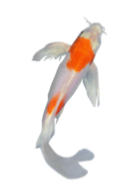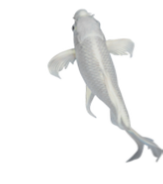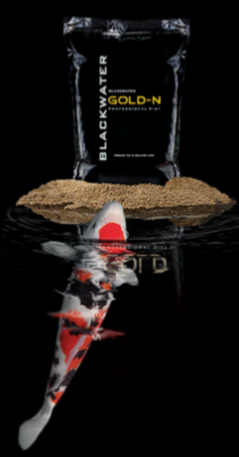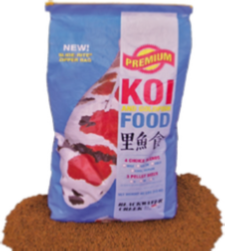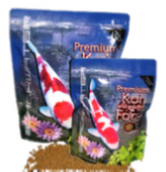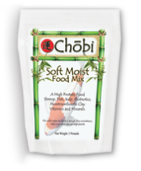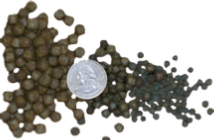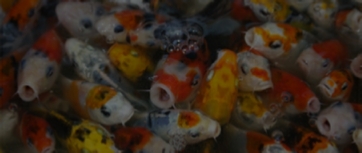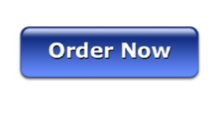How to grow Koi effectively
Knowing your Koi’s behavior and metabolism will help you keep them happy, healthy, and beautiful. Koi are in the Carp family but will eat like pigs, (also omnivores). It is important to feed them as much as they will eat, as often as possible, when they are most active. Koi are most active during the warmer months when the temperatures reach above 60 degrees. It is also important that the Koi food they get includes the proper dietary ingredients. The ideal percentages of Protein/Amino Acids, Fat, and Fiber are critical for beautiful, healthy fish.
The following chart shows what those ideal percentages for optimum growth and color. These percentages were developed by our Aquatic Nutrition (AQN) experts and have been proven effective for many years by Blackwater Creek Koi Farms, Inc., (one of the leading and largest Koi & Goldfish producers in the US).
Once you are providing the proper diet it is equally important to provide the proper size, ratio, and frequency. Koi food comes in small, medium, and large floating pellets. For optimum consumption the size should fit the fish’s mouth, depending on their age and size: 2 inch to 6 inch fish will eat small pellets, 7 inch to 12 inch fish will eat medium pellets, and 13 inch plus fish will eat large pellets.
Feed ratio refers to the amount of food a Koi eats that is converted to pounds of fish. If you feed 1.5 pounds of Aquatic Nutrition Koi food your Koi should gain approximately 1 pound in overall weight and 1 inch, per month, in overall length, when water temperatures are 70 degrees and higher. For an individual Koi to grow to 24 inches, or approximately 6 pounds, will require approximately 9 pounds of food from the time it is about 6 inches. The amount of time to grow a fish to this size is water temperature dependent along with good pond husbandry. The rule of thumb, when feeding a Koi pond, is to feed no more than the school of Koi can consume 15 minutes.
When using a low quality food, you may need to feed up to 5 times more food to get the same growth ratio. Many people have tried to use low quality fish foods, such as Catfish foods, and found that they lack certain nutrients that result is various fish aliments. Or they have used Koi Foods that, when inspect closely, resemble a “Puffed” snack food. These turn out to be mostly “air” and contain very little nutrients! It is more economical, in the long run, to use a high quality Koi feed.
The feed ratio will depend on the frequency your Koi are fed. We recommend “timed” feeders or “demand” feeders that will allow the fish to eat all day reaching their maximum consumption rate. If you like to hand feed your fish, which is always enjoyable, it would be best to feed small amounts 3-4 times per day. A good feeding rule of thumb is what they will eat in 15 minutes. Koi food goes “in and out” of the Koi in about 4 hours. This is the time it takes from “ingestion” to “expulsion”. Feeding too much is the quickest way to foul your pond, so be careful not to over feed.
As a commercial Koi farm operation, Blackwater Creek Koi Farms, Inc. uses automated feeders for efficiency and maximum weight gain. They also hand feed the Koi so they can make visual observations for healthy fish behavior and physical condition. Hand feeding Koi is the best way to truly enjoy your precious babies, apart from actually swimming with them in the pond (grin).
There are some other health considerations related to feeding Koi and Goldfish. Overfeeding can be as hazardous as under feeding. If Koi get too fat they can become egg bound, unable to release their eggs, and will die. Females being used for breeding should get a low fat diet. After they lay their eggs, the Koi food to feed is Gold-N. This diet is a higher fat content with high fish meal and will help replace the nutrients lost during spawning.
Fish that are less active, as they are in the winter, should get the AQN Cool Season/wheat germ Koi food. As the fish come out of the cool season they should only be fed if they are interested and coming to the feeder. Feeding Koi that aren’t eating will only foul the water and create more problems. Watching your fish’s behavior is critical to their overall health and your overall enjoyment.
Maintaining optimum water quality with no Ammonia, minimal Nitrite and warm water while feeding Aquatic Nutrition food and your fish will continue to grow and thrive. Aquatic Nutrition Koi Food is available through retail shops throughout the world under the trade name “Blackwater Creek”.

